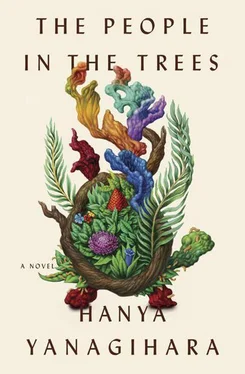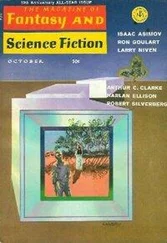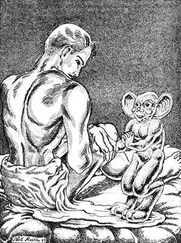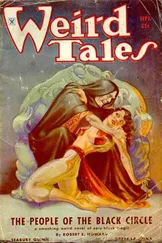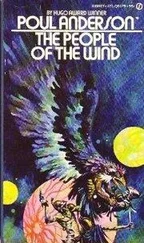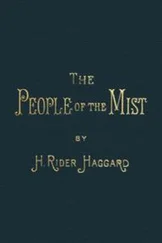I had assistance in this; I had been assigned a postdoctoral student named Cheolyu Ryu, who was on a visiting scholarship from Seoul. I’m not sure what he’d done wrong to be assigned to me, of all people — other than being a foreigner and, I’m sorry to say, somewhat inscrutable — but he was a great help. He was reluctant to speak English (though when I heard it, his English sounded fine, if heavily accented), but he followed orders closely and without any contradictions and kept fine notes. It was Cheolyu who was responsible for perfecting not only the formula of sedatives we fed the dreamers but the formula of stimuli as well; he knew exactly how much time spent outside their room would upset them and was even eventually able to take them outside the lab entirely for short periods at night, when the electric lights were dimmed and the grass was cool under their feet and the buildings’ other occupants — from whom we kept the dreamers’ existence — had left for the day. Sometimes I would go with him on these night rambles, each of us holding two of the dreamers’ hands, and follow him across the short, well-kept lawns, avoiding the sidewalks and the buildings, waiting as they exploratorily lapped at the bark of a eucalyptus and rubbed their shoulders against a spindly cedar. At these times he reminded me of no one so much as poor Fa’a; they shared the same indulgent patience, the same protective instincts, the ones that made him swerve the dreamers away from concrete and guide them toward a grove of beeches that might as well have been flowers, so little did they resemble manama trees, but were better, I suppose, than nothing.
The dreamers were deteriorating very quickly now. Indeed, they had become more … well, mo’o kua’au-ish in the first month following our return than they had in the fourteen weeks or so that I had known them on the island. Again, it was impossible to conclude definitively whether this was because of their environment or organic, or whether it was for some other reason entirely — diet, perhaps. Naturally, no manama fruits were available, but with Tallent’s help I had re-created as closely as I could an Ivu’ivuan diet. We had substituted veal for sloth meat (though I fear that that parallel was grounded more in sentiment than anything else; my logic, I seem to recall, was that sloths were slow-moving and fatty and gentle and so were calves, and therefore the latter might make an even swap for the former), small rotisseried chickens for the vuakas, and mangoes for the manamas. Back then it was much harder to find mangoes in northern California than it is today, and a significant percentage of the lab’s expenses was dedicated to the procurement and purchase of the fruit.
Still, one did not have to be particularly bright to recognize that the culprit was probably the lab itself. The dreamers had gone from wandering the forest — the whole length and width of an island — to being confined in their room, or if not their room, the lab beyond, where they were pricked and poked and swabbed and made to urinate in plastic cups (something they had never seen before) and plucked like birds. I sometimes wondered what the lab represented to them: too much stimulation or not enough? On one hand, there were things that they could not even begin to comprehend — glass, for example, and ceramic countertops, and plastic and metal. But on the other hand, the lab was so arid. It was an albinic landscape, one without any color or sound or smell beyond a chilly metallicism, one with nothing to dazzle and delight an eye that had been dazzled and delighted all its life.
Whatever the reason, they became deader and deader with each day. Not physically; indeed, the only thing that was remarkable about their X-rays, their reflex tests, the substantial quantities of blood we siphoned from their veins each week was how extraordinarily physically healthy they were — their blood pressure admirable, their pulses thudding as softly and unhurriedly as metronomes, their bones unnibbled by osteoporosis. But as if in compensation for their bodies, which, once exposed to food other than manamas and those shingley mushrooms, grew sleeker and plumper, their minds diminished piece by piece. Soon not even Mua could find the energy to make conversation with Tallent when he came by on his twice-weekly visits.
“E, Mua,” Tallent would greet him, resting a hand on his shoulder, and Mua, as if from a great depth, would slowly raise first his eyes and then his head to see who was talking to him. He would open his mouth but make no sound. And there they would remain, until finally Tallent would take his hand away and show him the mango he had hidden behind his back. But Mua would only gaze at that too, and at last Tallent would have to cut it and remind him that it was to be eaten and enjoyed, opening his mouth and inserting a fibrous sliver of it, chewing and swallowing until Mua realized that this was something he was still capable of doing.

In order to prove my theory — that ingestion of the opa’ivu’eke was responsible for the dreamers’ superannuated lives and eventual decline — I had to try to re-create their condition in animals. But owing to various administrative difficulties (that is, the perpetual twin problems of funding and space), I was not able to begin my experiments until the spring of 1951. 49
My homemade curing seemed to have worked very well, but I guarded the packets of meat, still wrapped in palm leaves, almost maniacally, storing them first in plastic containers and then in the lab’s freezer, the temperature of which I checked daily. I cursed myself for being too cowardly to rip off the creature’s shell and save the meat within; now I had only the four legs and head and the flap of tail, and who knew how much turtle the mice would have to consume in order to experience its effect? Who knew how carefully I would have to ration my remains? There was no way of getting more opa’ivu’eke; I was committed to the lab, and although Tallent was already planning his return to Ivu’ivu for the summer, I couldn’t ask him to get me another — he didn’t even know I had this one.
So I was very careful with the amount of turtle I fed the first group of twenty-five mice. I made Cheolyu cut a section of the foreleg into twenty-five snippets, each no larger than a thumbtack. I had to hope that it would be enough. I was working under the assumption that the results would be apparent — or not — from only one feeding; either it would work or it wouldn’t. The other twenty-five mice I fed similar-sized portions from a box turtle I had bought from an animal supply company.
The maximum lifespan for a lab mouse is about a year and a half. If my theory was correct, the first group of mice would be alive not only three months from now (I had specified that all fifty be fifteen months old, to best re-create the age at which an Ivu’ivuan would ingest his opa’ivu’eke) but after two years, three years, perhaps even five years. At some point they would begin to behave in a disoriented manner, even as their physical condition remained essentially unchanged. I had also replicated, somewhat prematurely and almost as a lark, the experiment on a second group of one hundred mice, half of whom were fed the opa’ivu’eke, and the other half, the box turtle. These mice, however, were newborns and would essentially come of age in a controlled experimental environment.
The days churned by. Cheolyu took excellent care of the mice, and excellent care as well of the dreamers. I had somehow expected Tallent to be a more frequent presence in the lab, but aside from his weekly visits — which were spent mostly in the company of the dreamers — I seldom had reason or opportunity to speak with him, and when I was in his presence, I felt more, not less, awkward. After we began the experiment, I was grateful for his brief visits and his apparent lack of interest in what I was doing; explaining my intentions would mean revealing my theft of the opa’ivu’eke. Part of me suspected that Tallent was somehow aware of what I’d done, and another part of me argued that he wouldn’t care — we were off the island, back in civilization, and he no longer had any jurisdiction over me. But in the end, neither of those arguments proved compelling enough to convince me, and I found myself making excuses and scuttling away whenever he stopped by. At least he came alone, unaccompanied by Esme, whom I hadn’t seen since our return. I knew she was somewhere on campus, doing something or other, but as long as I didn’t have to see her or contemplate further her still unresolved (at least to me) relationship with Tallent, I was satisfied.
Читать дальше
